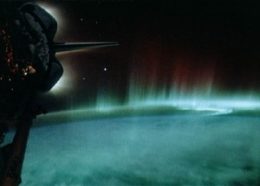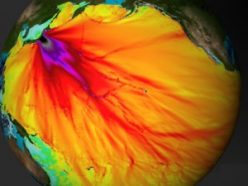Tsunami’s trek traced in the sky
Scientists photograph atmospheric ripples that followed the March tsunami across the Pacific

In March, an earthquake shook the seafloor 80 miles east of Japan. It released a fast and powerful wave, called a tsunami, which struck the island nation and caused death and destruction. The recovery could take years. Newspapers and websites carried images of the catastrophe caused by the tsunami.
Thousands of miles away, a team of scientists happened to catch tsunami-related images of a different kind. These photographs, taken by a camera in Hawaii, showed glowing ripples that moved across the sky. Though tsunamis are better known for disrupting water, they can also stir things up in the atmosphere, high over head. The ripples in the sky had been caused by the tsunami — and they were following the wave as it moved eastward across the Pacific Ocean.
Jonathan Makela led the study of the photographs, which are the first of their kind. He is a space scientist at the University of Illinois at Champaign-Urbana. Makela told Science News that he and his colleagues hadn’t set out to photograph the tsunami-caused ripples. The camera just happened to be in the right place at the right time.
“It’s just total serendipity that we got this measurement,” Makela said.
The camera used by Makela and his colleagues sits atop Haleakala volcano on the island of Maui. Every night, it shoots photos of the sky. These photos can help scientists learn about changes and events in the ionosphere, which is part of the upper atmosphere.
The ionosphere gets its name from ions, which are electrically charged atoms. The charge of an atom depends on its number of electrons, which are negatively charged particles. An atom may be positively charged, which means it’s missing some electrons. Or an atom may have a negative charge, which means it has extra electrons. In the ionosphere, radiation from the sun knocks electrons off atoms.

The tsunami that sped across the Pacific was only about 20 centimeters (almost 8 inches) high in the open ocean. But even that small boost sent particles racing up, up, up — all the way to the ionosphere, where particles smashed into each other. When charged particles are involved, these collisions can produce energy in the form of light, which can appear as glowing ripples.
Other scientists have studied the ionosphere in the wake of tsunamis, but Makela and his team are the first researchers to produce pictures of the ripple phenomenon. Makela told Science News that in the future, cameras might be useful to warn people that a tsunami is on its way. If fast-moving, atmospheric ripples are approaching, scientists can sound the alarm.
Makela and his team are now thinking about installing sky-watching cameras in other places where tsunamis are common, like the Indian Ocean. The sky seems like an unusual place to watch for signs of a tsunami, but it is connected to the air and the sea — and what happens in one place has effects in the other.
“It’s a really neat example of how the environment is coupled together,” Makela says.
POWER WORDS (adapted from the New Oxford American Dictionary)
ionosphere The layer of Earth’s atmosphere that contains many ions and free electrons. It extends from about 50 to 600 miles above Earth’s surface.
electron A tiny particle with a negative charge.
atom The basic unit of a chemical element. An atom has a nucleus, which may include particles called protons and neutrons. Surrounding the nucleus is a cloud of electrons, which are negatively charged particles.
ion An atom with an electric charge due to the loss or gain of one or more electrons.
tsunami A long, high sea wave caused by an earthquake, landslide or other disturbance.







